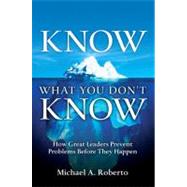
What is included with this book?
Michael A. Roberto is the Trustee Professor of Management at Bryant University in Smithfield, Rhode Island, after six years as a faculty member at Harvard Business School. His research, teaching, and consulting focus on strategic decision-making processes and senior management teams. He is the author of Why Great Leaders Don’t Take Yes for an Answer (Wharton School Publishing, 2005).
| Acknowledgments | p. xii |
| About the Author | p. xv |
| Preface | p. xvi |
| From Problem-Solving to Problem-Finding | p. 1 |
| Embrace Problems | p. 6 |
| Why Problems Hide | p. 9 |
| Cultures of Fear | p. 9 |
| Organizational Complexity | p. 11 |
| Gatekeepers | p. 13 |
| Dismissing Intuition | p. 14 |
| Lack of Training | p. 15 |
| Making Tradeoffs | p. 17 |
| Becoming an Effective Problem-Finder | p. 18 |
| The Isolation Trap | p. 20 |
| Circumvent the Gatekeepers | p. 27 |
| Why Filtering Takes Place | p. 31 |
| Efficiency Concerns | p. 31 |
| Pressures for Conformity | p. 32 |
| Confirmation Bias | p. 33 |
| Advocacy | p. 34 |
| Circumventing the Filters | p. 35 |
| Listen with Your Own Ears | p. 36 |
| Seek Different Voices | p. 39 |
| Connect with Young People | p. 41 |
| Go to the Periphery | p. 43 |
| Talk to the Nons | p. 45 |
| A Most Prescient Leader | p. 46 |
| Become an Ethnographer | p. 53 |
| Why Don't People Do What They Say? | p. 57 |
| Leading Questions | p. 58 |
| Group Dynamics | p. 59 |
| The Unconscious Mind | p. 61 |
| Honing Your Powers of Observation | p. 62 |
| A Few Words of Caution | p. 66 |
| Hunt for Patterns | p. 73 |
| What Is Intuition? | p. 75 |
| Faulty Analogies | p. 77 |
| Solutions in Search of Problems | p. 80 |
| Building Your Pattern-Recognition Capabilities | p. 84 |
| Better Analogies | p. 84 |
| Mentoring | p. 87 |
| Mining the Data | p. 89 |
| What Do You Learn at Business School? | p. 90 |
| Connect the Dots | p. 95 |
| The CIA in Kuala Lumpur | p. 97 |
| The Phoenix Memo | p. 98 |
| The Minneapolis Field Office Investigation | p. 99 |
| The 9/11 Attacks | p. 100 |
| Why Not Share Information? | p. 102 |
| Information Sharing in Small Groups | p. 104 |
| How to Facilitate Information Sharing | p. 106 |
| Leading Teams | p. 107 |
| Leading Organizations | p. 109 |
| Mindset Matters | p. 112 |
| Encourage Useful Failures | p. 119 |
| Why Tolerate Failure? | p. 121 |
| Acceptable Versus Unacceptable Failures | p. 125 |
| Before the Failure | p. 126 |
| During the Failure | p. 127 |
| After the Failure | p. 130 |
| Useful, Low-Cost Failures | p. 132 |
| Teach How to Talk and Listen | p. 139 |
| Crew Resource Management Training | p. 143 |
| Communication Errors | p. 145 |
| Improving Interpersonal Communication | p. 147 |
| Briefings | p. 147 |
| Handoffs | p. 149 |
| Speaking Up Effectively | p. 151 |
| Listening | p. 155 |
| Train Teams, Not Individuals | p. 156 |
| Watch the Game Film | p. 161 |
| After-Action Reviews: Promise and Peril | p. 166 |
| Competitor Intelligence: Promise and Peril | p. 173 |
| Deliberate Practice | p. 176 |
| Looking in the Mirror | p. 180 |
| The Mindset of a Problem-Finder | p. 185 |
| Three Dimensions of a New Mindset | p. 189 |
| Intellectual Curiosity | p. 189 |
| Systemic Thinking | p. 191 |
| Healthy Paranoia | p. 192 |
| Index | p. 195 |
| Table of Contents provided by Ingram. All Rights Reserved. |
The New copy of this book will include any supplemental materials advertised. Please check the title of the book to determine if it should include any access cards, study guides, lab manuals, CDs, etc.
The Used, Rental and eBook copies of this book are not guaranteed to include any supplemental materials. Typically, only the book itself is included. This is true even if the title states it includes any access cards, study guides, lab manuals, CDs, etc.